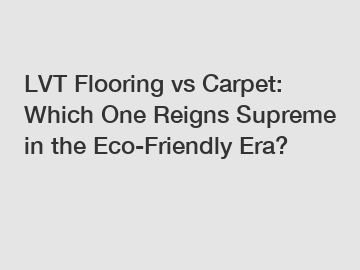LVT Flooring vs Carpet: Which One Reigns Supreme in the Eco-Friendly Era?
LVT Flooring vs Carpet: Which One Reigns Supreme in the Eco-Friendly Era?
In the modern era, environmental sustainability has become a crucial aspect of our lives. As we strive to make greener choices, it's important to consider sustainable options for our homes as well. When it comes to flooring, two popular choices that often come under scrutiny are LVT (Luxury Vinyl Tile) flooring and carpet. Both have their own advantages and disadvantages, but which one truly reigns supreme in the eco-friendly era?
Environmental Impact: A Comparison.

1. LVT Flooring.
LVT flooring is made primarily from PVC resin, which is a synthetic material. While the production process for LVT does require energy and chemicals, it has a lower environmental impact compared to other flooring options. LVT flooring is highly durable, long-lasting, and requires minimal maintenance. This means that it doesn't need to be replaced often, reducing waste over time. Additionally, LVT is 100% recyclable, making it a sustainable choice.
2. Carpet.
Carpet, on the other hand, is typically made from natural or synthetic fibers such as wool or nylon. The production process for carpet involves resource-intensive activities, including farming, dyeing, and manufacturing. These processes can have a significant impact on the environment, including water and air pollution. Additionally, carpet has a limited lifespan compared to LVT flooring and needs to be replaced more frequently. The disposal of old carpet also presents challenges, as it often ends up in landfills.
Health and Indoor Air Quality Considerations.
1. LVT Flooring.
LVT flooring is often praised for its ease of maintenance and resistance to water and stains. Unlike carpet, it doesn't trap dust, pollen, or other allergens. This makes LVT a suitable choice for individuals with allergies or respiratory conditions. Additionally, LVT flooring is compatible with radiant heating systems, providing a comfortable indoor environment.
2. Carpet.
Carpet, despite its comfort and warmth, can harbor allergens, dust mites, and other pollutants. Regular vacuuming and deep cleaning are necessary to maintain a healthy indoor environment, especially for individuals with respiratory issues. Additionally, some carpets contain volatile organic compounds (VOCs), which can affect indoor air quality negatively. Opting for eco-friendly carpet options made from natural fibers and non-toxic materials can mitigate these concerns.
Final Verdict: Choosing the Best Option.
While both LVT flooring and carpet have their own benefits and drawbacks, LVT flooring has a slight edge in terms of eco-friendliness. Its durability, recyclability, and low maintenance requirements make it a sustainable choice. Moreover, LVT flooring offers better indoor air quality since it doesn't trap allergens like carpets do.
If you're looking to make your home more eco-friendly, LVT flooring may be the superior choice. Its long lifespan and minimal impact on the environment make it a sustainable option for the eco-conscious consumer. However, it's important to consider other factors such as personal preferences, budget, and specific requirements when making a flooring decision.
To learn more about eco-friendly flooring options or to discuss your specific needs, feel free to contact us. Our team of experts is here to assist you in finding the best flooring solution for your home while prioritizing sustainability. Together, let's make conscious choices to protect our planet and create a greener future.
Are you interested in learning more about homogeneous flooring manufacturer, spc flooring living room, is spc flooring environmentally friendly? Contact us today to secure an expert consultation!

Comments
0